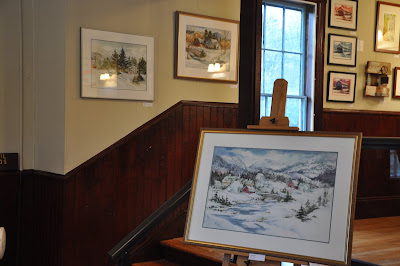Wednesday, August 18, 2010
WANTED
Tuesday, May 18, 2010
Artist: June McLeavey

This monotype began with local flora collected along roadsides and from my garden. The timeless, ethereal figure appears to be walking forward into the future and is caught in a moment when she is casting a glance backward into the past.

One of my first delights in exploring the woods around our Jackson home was the discovery of a grouping of Lady’s Slippers. I feel a connection in time and place when I consider how this simple pleasure has been shared with generations before me, and with the proper care, will continue for generations to come.
This piece, created in celebration of the new Jackson library, was made from wood, nails and fabric salvaged from the Trickey Barn. The stone from Jackson Falls hangs in a crocheted pendulum and represents the delicate balance between preserving the past and preparing for the future. The library project is a magnificent example of our community coming together to preserve a truly exceptional piece of our “Ever Present Past”.
Artist: Leslie Fletcher
Thursday, May 6, 2010
Artist: Anne Garland


About 12,000 years ago, the last of the enormous ice sheets which once topped the Presidentials by a mile or more began to melt away to leave the landscape much as we now see it. Each mountain that surrounds the town of Jackson was left with its own defining shape and geological features. Since the first settlers arrived, the surface of the land has been altered according to human needs and interests, but the underlying profile and character of each mountain has remained unique. For example, while looking at old photographs or paintings of Jackson, the old roads, fields, or buildings once present but now gone or altered make it difficult or perhaps impossible to determine where the photographer or artist once stood. But if one of the surrounding mountains appears in the image showing a particular slant of slope, ledge, or other natural feature, the location can be identified. The geological past will always find its way into our everyday lives, consciously or not, dictating how and where we move about, build our homes, or use the land. The painting “Stonewall and Doublehead Mountian”, because of its distinguishing features, marks the location where one could view it. This mountain along with Eagle, Spruce, Black, Iron, Tin, Thorn, Midldle, remain silent yet ever present, representing a continuation of time both past, present, and future that is almost unimaginable.
The geological past is also ever present in our lives by way of the stonewall. When we see and touch the crumbling and abandoned walls that weave fragmented in and about the landscape, we are witnessing the ancient stones that were distributed eons ago by the same glacial forces that sculpted the venerable mountains. These stones were at first buried beneath thick loamy soil from which grew a lush deciduous forest. The mid-eighteenth century brought European settlers and a resulting deforestation into the northern landscape, in time causing the ancient stones to surface, and stonewalls to be built. These hard rock fieldstones were of a size and shape that could be lifted and fit together, piled and used as walls to confine livestock, mark boundaries, line roadways, or used for house and barn foundations. Each wall is unique, some beautifully and artfully fashioned, others crude. Stonewalls are New England’s architectural ruins, tangible threads connecting us to our past. Worn and gray with their mosses and lichens, they hold stories and secrets we can only wonder about: Who built this one, when and why? And for what purpose does it end or begin here or there? In the painting “Stonewall and Old Spruce” the forest has returned, but even in deep winter an old stonewall insists upon subtly appearing from under the snow. In the etching “Stonewall” the snow reveals a wall that is crumbling. One might ask, “What is crumbling?” “What is beyond the wall: all of winter’s light, or all of winter’s dark?” “What is hidden behind it, yet to emerge?”
Artist: Kathy Speight Kraynak



Artist: Holly Manneck
























